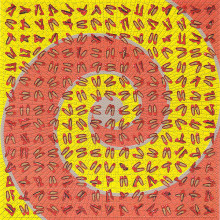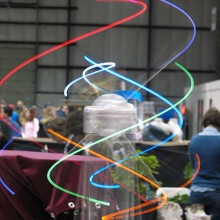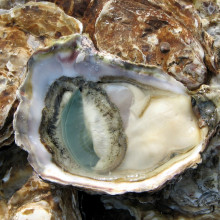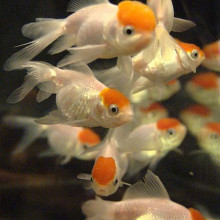This week, we find out how a giant parachute could help avoid satellite collisions, why the schizophrenic brain can't see a popular optical illusion and discover that all octopodes (or octopuses?) are poisonous! Plus, we take on your science questions, discussing cycling on the moon, electric fences and couples getting tazered together. In Kitchen Science, we make a sprinkler from a spinning straw!
In this episode

Parachutes for rockets
After the recent collision between an american satellite phone satellite and a defunct russian satellite the problem of space junk has become more obvious. One major source of space junk is spent upper rocket stages which are lifted high enough to reach orbit.
These rocket stages are particularly dangerous to satellites as they often still contain fuel and if this vents they can change direction unpredictably or even explode.
In a low earth orbit there are faint wisps of an atmosphere and this will eventually slow down the debris and cause it to deorbit, but this will take at least 100 years could take thousands.
Max Cerf and Brice Santerre at the European aerospace firm EADS Astrium may have a solution. This involves attaching a super-light sail arrangement onto the rocket which deploys once the rocket has released its satellite. This would be supported by an inflatable structure probably impregnated with epoxy so that it would become solid and last a long time. For an Ariane 5 rocket it would have to be about 350 square metres.
This sail or aerobrake would then increase the air resistance enough to cause the rocket to come back to earth in only a couple of decades, hugely reducing the buildup of space junk in low earth orbit.

Ancient pharaohs sipped medicinal tipple
Swigging back an aspirin dissolved in a glass of wine may not be a common way of taking medicines these days, but that was what the ancient Egyptians were up to at least 5000 years ago.
 A team of archaeologists have discovered traces of medicinal plants in ancient wine jars buried in the tomb of one of Egypt's first pharaohs, Scorpion I. This provides the first physical evidence that the ancient Egyptians prescribed themselves plants steeped in wine as herbal remedies.
A team of archaeologists have discovered traces of medicinal plants in ancient wine jars buried in the tomb of one of Egypt's first pharaohs, Scorpion I. This provides the first physical evidence that the ancient Egyptians prescribed themselves plants steeped in wine as herbal remedies.
In the study, published in the journal PNAS, Patrick McGovern from the University of Pennsylvania in Philadelphia in the US and his team analysed residues left behind in ancient pottery wine jars excavated from a tomb in Abydos in upper Egypt, and found the chemical signature of tartaric acid, a good indicator that they once contained wine. They also isolated the chemical traces from several active compounds found in plants.
Plants contain all sorts of chemicals with powerful medical properties and they are the oldest form of natural medication that people have used all around the world for thousands of years. There are even other animals, including chimpanzees and starlings, that have learnt to use plants to treat various ailments.
Ancient Egyptian papyrus dating back to 1850 BC hint at the use of medicinal tipples, and this new discovery confirms the Egyptians had figured out the medicinal properties of various plants and that dissolving them in alcohol was a good way of administrating them. And it pushes back that date to at least 5000 years ago.
Now McGovern and his team are refining their analysis of the medicinal wine residues and hope to pinpoint which blend of herbs were used. They then plan to put them to the test and find out whether the Egyptians had struck on a combination of plants that could help treat diseases of the twenty-first century.

Schizophrenics don't fall for illusions
Normal human subjects are readily fooled by a 3D representation of a face mask, but schizophrenics are not.
 This visual trick is known as the hollow mask illusion and consists of a 3D representation of a hollow, concave mask of a face, viewed pointing inwards. When healthy individuals look at this, more than 99% of the time what they report seeing is a normal face that is convex. This illusion exploits the brain's system for making sense of the visual world by superimposing what it expects to see, based on past experience and memories, with what it is actually seeing. Yet patients diagnosed with schizophrenia almost never fall for it and instead report seeing a "hollow" face.
This visual trick is known as the hollow mask illusion and consists of a 3D representation of a hollow, concave mask of a face, viewed pointing inwards. When healthy individuals look at this, more than 99% of the time what they report seeing is a normal face that is convex. This illusion exploits the brain's system for making sense of the visual world by superimposing what it expects to see, based on past experience and memories, with what it is actually seeing. Yet patients diagnosed with schizophrenia almost never fall for it and instead report seeing a "hollow" face.
But why? To find out a joint UK and German study published in the journal Neuroimage brain scanned 16 healthy volunteers and 13 schizophrenics as they experienced the illusion, which was presented to them using a 3D headset. Hannover Medical School researcher Danai Dima, together with UCL scientist Jonathan Roiser, then compared the brain scans and found that, in the healthy controls, a region of the brain called the parietal cortex increased its connectivity to the brain's primary visual areas when the image was being presented. In the schizophrenic patients, however, this activity boost did not occur.
What this shows, the researchers explain, is that in schizophrenics there is a connectivity problem whereby they struggle to unite the contributions of different brains regions and therefore experience stimuli as their raw components. Whilst this makes them immune to visual illusions it also means that they cannot, for instance, tell internally generated stimuli, such as a voice in their head, from stimuli originating from outside the body, such as someone else's voice.
Intriguingly, it's not just schizophrenia sufferers who cannot experience this illusion. Smoking cannabis also prevents people from seeing it, suggesting one action of this drug might be to provoke a stage of dysconnectivity between different brain regions, perhaps explaining the observed link between cannabis use and an increased risk of developing psychosis.

Toxic octopodes?
Octopuses hit the science headlines this week, with the news that, contrary to popular belief, all species of these soft-bodied, eight-armed denizens of the deep are in fact venomous, solving the enduring maritime mystery of how octopuses kill their prey.
 The same goes for the octopus's cousins the cuttlefish and some squid too.
The same goes for the octopus's cousins the cuttlefish and some squid too.
But they are all harmless to people, except for the stunning but lethal blue-ringed octopus, a tiny creature at around 15cm, which lurks in tropical coral reefs.
In a study published in the Journal of Molecular Evolution, Byron Fry and from the University of Melbourne in Australia led a team of scientists on octopus collecting expeditions to Australia's Great Barrier Reef, and the waters of Hong Kong and Antarctica.
As well as finding venom proteins in many different species of cephalopod (a class of molluscs that includes octopus, cuttlefish and squid) the team also pinpointed the genes that code for these proteins and discovered that among all the various species, the venom gene was inherited from a single common ancestor.
It turns out that octopus venom is very similar to proteins in other animals like snakes. All these different animals evolved independently but came up with a similar way of creating a toxic molecule. This new octopus discovery sheds light on what makes certain molecules venomous and should pave the way for the development of new drugs for treating pain, allergies and cancers.
And it means that we finally know how octopuses kill their prey: They grab a tough-shelled crab with their suckered tentacles, pierce its shell with their sharp beak then use their venom to kill their victim.
But it leaves us with the eternal conundrum: What is the plural of octopus? Is it octopuses? Octopi? Octopodes? Or perhaps octopussies?

14:23 - Bicycle Day - The Discovery of LSD
Bicycle Day - The Discovery of LSD
with Professor Philip Strange, Reading University
Chris - 66 years ago the famous Bicycle Day occurred. Bicycle Day was when Dr Albert Hofmann, who was a researcher in Basel was working on something which has subsequently spawned an entire revolution. The psychedelic revolution. He took a famous trip home on his bicycle home from work after inventing what subsequently became known as LSD - Lysergic acid diethylamide. He was doing it by studying a fungus that grows on wheat. His discovery was entirely accidental. To tell us a little bit about it is Professor Philip Strange, who's the Director of Pharmacology at the University of Reading. Hello Philip. Tell us a bit about this momentous anniversary that we're celebrating today, in effect this week.
 Philip - Hofmann, as you said, was an organic chemist working in Sandoz in Basel in the 1940s. He was working on the chemical derived from the fungus ergot. One of the chemicals he made, based on the ergot, was LSD. On April the 16th, 1943 he was working on LSD and he experienced the funny effects including hallucinations after working with the chemical. He went home for the weekend and on the 19th of April - 66 years ago today - he came to verify these effects of the drug. He took a quarter of a milligram of the drug and experienced the same psychedelic effects again only much more strongly. It was actually a very large dose to take as we now know. He felt very odd that day, experienced these psychedelic effects and decided to go home. This was war time; there were no cars so he used his bike. The crazy bicycle ride home through the streets of Basel under the influence of LSD was the first demonstration of the powerful psychedelic effects of the drug. It's termed bicycle day in the psychedelic counter-culture.
Philip - Hofmann, as you said, was an organic chemist working in Sandoz in Basel in the 1940s. He was working on the chemical derived from the fungus ergot. One of the chemicals he made, based on the ergot, was LSD. On April the 16th, 1943 he was working on LSD and he experienced the funny effects including hallucinations after working with the chemical. He went home for the weekend and on the 19th of April - 66 years ago today - he came to verify these effects of the drug. He took a quarter of a milligram of the drug and experienced the same psychedelic effects again only much more strongly. It was actually a very large dose to take as we now know. He felt very odd that day, experienced these psychedelic effects and decided to go home. This was war time; there were no cars so he used his bike. The crazy bicycle ride home through the streets of Basel under the influence of LSD was the first demonstration of the powerful psychedelic effects of the drug. It's termed bicycle day in the psychedelic counter-culture.
Chris - Although it obviously didn't harm him too much because he died last year at the age of 102. What was he actually trying to achieve? Obviously not to make an hallucinogen. He was working on these agents for some reason, presumably not with that reason in mind though.
 Philip - The LSD was just an accident, really. The Sandoz were interested in the business of making new drugs. They wanted to look at different sources. They chose a natural product - this ergot which grows on wheat and also on rye as well. It contains all sorts of interesting chemicals. For example, preparations of ergot have been used for years to quicken labour and the Sandoz isolated the actual compound: ergometrine from that. It's still used to stop haemorrhaging after childbirth.
Philip - The LSD was just an accident, really. The Sandoz were interested in the business of making new drugs. They wanted to look at different sources. They chose a natural product - this ergot which grows on wheat and also on rye as well. It contains all sorts of interesting chemicals. For example, preparations of ergot have been used for years to quicken labour and the Sandoz isolated the actual compound: ergometrine from that. It's still used to stop haemorrhaging after childbirth.
Chris - Because it constricts arteries, doesn't it? Doesn't the same drug also prove useful in the treatment of migraines by preventing the blood vessels in the brain from dilating?
Philip - That's ergotamine. It's similar but it's a different compound. It works very similarly to the tryptan which everybody has taken over in the treatment of migraines.
Chris - Do we know how LSD actually does what it does?
Philip - We don't know clearly. What LSD does is it hijacks some of the receptors in the brain for one of the chemicals called serotonin. Serotonin is a neurotransmitter - a brain chemical which is very important for transmitting messages in our brain. It's involved in all sorts of different things like emotion and constricting arteries as you've said. It acts by binding to proteins called receptors. LSD basically binds to those receptors and hijacks and affects it. It's not surprising it has these complex effects.
Chris - Why is it that some people experience bad outcomes from taking this though? Even Hofmann himself said that you can sometimes get bad trips where rather than seeing nice things you see nasty things.
 Philip - I don't know the answer to that question, really. One thing is if people take too much. It was espoused by the hippy culture and if they used it in a very uncontrolled manner there that's one reason. Other reasons are that people are all different in the way they react to these things - different drugs and so on. Also the preparations of the drug that people are being given are not pure.
Philip - I don't know the answer to that question, really. One thing is if people take too much. It was espoused by the hippy culture and if they used it in a very uncontrolled manner there that's one reason. Other reasons are that people are all different in the way they react to these things - different drugs and so on. Also the preparations of the drug that people are being given are not pure.
Chris - Just to finish off, I think this does tell us quite a bit about how we go about finding drugs. Helen was saying that, if you look at an octopus there may be genes which it uses to make toxins and those toxins that kill things could also prove therapeutically useful. I think the science that Sandoz was doing that accidentally led to the generation of LSD, in itself was a sound way to discover drugs.
Philip - It is and it's still used by some companies nowadays. Particularly the deep sea organisms contain new structures on which you can base new drugs.

Pumping Straw - a centrifugal pump
Why do you see speckles when you sneeze?
Chris - That's a fantastic question. Have you guys seen this?
Helen - Hmm. Yeah. Dave - Quite often see white speckles in front of my eyes just when it's dark. Chris - This is what's called an entoptic phenomenon. In other words, it's a visual hallucination, effectively which is arising from within your eyeball. There's a number of possibilities here. I think that we could be seeing one of two things. One is that if you stimulate your eye: because the retina's very sensitive to pressure if you just push on the side of your eye you'll see an hallucinogenic light display. You can do it yourself just by pressing the side of your eye. Try that. If you press on the side of your eye you can see some interesting colours. I'm not saying poke your eye out. Just apply gentle pressure to the side of your eye. This is because the retina is sensitive to pressure and I think it causes discharges of different bits of the retina which I think causes those visual hallucinations you see. They're just photo-receptors firing off as though they've seen light they haven't really seen. When you sneeze you've got air jetting out of your nose, ricocheting around at 100 miles an hour. I suspect that the vibration of the air coming out of your nose probably impacts on air that's in your sinuses which are like cul de sacs. You pressurise the air in your sinuses. This causes a shockwave, probably, to reverberate through your skull. I suspect some of that shockwave might go into your eyes and it could therefore cause the retina to jolt a little tiny bit. The fact that not everyone gets that and everyone does sneeze a lot says that it's unlikely. I was poking round and I found a very interesting comment on the internet about someone called Scheerer and Scheerer's phenomenon. This is amazing because it's used as a way of measuring blood flow through the retina. What you see when you look at a lovely blue sky and nothing else in the visual world. You see these little white speckles coming in they follow a very stereotype path. If you keep watching them you'll see that they all tend to take the same pathway: a wiggly line running in from one part of your retina to another. They're not random, they're coming in and flowing. These are white blood cells and what's happening is because they're very infrequent compared with red blood cells they only crop up now and then as these white blobs. When you look at the blue sky the red blood cells which your blood vessels are full of absorb the blue light quite well. The white blood cells which are infrequent don't. They reflect it and you see a white sparkle on your retina. That's why you see these white blobs when there's nothing else in the visual world to distract you.
I wonder if what's going on with that question is that maybe the sneeze provoked him to look at the sky and he then saw what's called Scheerer's Phenomenon. People can be trained to look at a computer screen and track the number of white blood cells they see come across. This can be used as a measure of retinal blood flow if you don't have another fancy way of doing it. Isn't that amazing?
Helen - That is crazy.
Dave - The other kind of speckle I've noticed occasionally is if it's very dark everything seems to be covered with a very fine speckle - a bit like noise on a TV screen.
Chris - That's called prisoner's or captives' hallucinations. This is where your retina is tuning itself to the ambient conditions. You know how you go from a bright room to a dark room and your retina (over the course of about half an hour) changes its sensitivity. You couldn't see in the dark but now you can. That's your retina tuning up the sensitivity of photoreceptors, making them more sensitive. You use rods rather than cones. You increase the connections between cells to increase the signal. It's a bit like if you take your radio and the signal coming out is not very good you turn the volume up. What your eyes are effectively doing is turning their volume up to become more sensitive to the light that's coming in. Because there's almost no light coming in you start to even see the noise that's being made in your retina, even though there's no signal there. People who go in caves will say if you turn all the lights out in a cave so it's genuinely jet black you see this a lot. Prisoners who are kept in solitary as a form of torture - nasty stories from that.
Why do planets spin in a particular direction?
Dave - I think basically it's random chance. If you start off with matter evenly spread out over the universe and everything's moving round a bit randomly. Some bit are moving a little bit in one direction, other bits are moving a little bit in another direction. Some large areas will have ever-so slight spin in one direction and other large areas will have slight spin in another direction. Then if that collapses with gravitational collapse if you've ever tried to climb into the centre of a roundabout in a playground it spins faster and faster. If you've ever watched an ice skater when an ice skater moves all of her mass into the centre then she spins faster and faster. This minute amount of rotation started off by a huge scale increases and collapses under gravity. There' conservation of angular momentum so it speeds up and speeds up. Some galaxies will be spinning in one direction, others in another direction. Chris - We should see a roughly equal proportion of each.
Dave - Basically random.
Chris - There should be some systems a bit like our solar system where instead of the planets going one way round the sun they could all be going the other way around the Sun. But you shouldn't ever see cosmic billiards going on where one planet's going one way and the other's going the other.
Dave - Unless...
Chris - Unless something catastrophic has happened.
Dave - I think on the individual solar system there's quite a lot of catastrophic stuff which has gone on. You're probably talking more about galaxies sort of averaging to make it work.

Are snakes susceptible to their own venoms?
Helen - That's a great question. There are two things to consider. That is, they aren't susceptible to their own venom in their own fangs, because they don't kill themselves every time they make some venom.
That's pretty cool but also quite easy to understand. We also have poisonous chemicals inside our bodies that don't kill us. They're kept in certain areas, for example, our pancreas contains a deadly cocktail of enzymes. If your pancreas bursts and they all come out then that can really spell a big problem for you and you start digesting yourself from the inside. But because these enzymes are kept in certain organs that are lined with cells that aren't susceptible to those enzymes, then you're okay. And once it goes into your digestive tract then you're okay, because the tissue there has protection to help it to cope with it.
This is also why if a snake happens to swallow some of its own venom it will be okay, because the venom is made of protein. So the venom will break down when it gets into the digestive juices in the stomach.
The other question is what if a snake accidentally bit itself or if another snake bit it? The answer seems to be yes, they are susceptible to their own venom. If it's injected into their system they can be susceptible to it, but some scientists have also found anti-venom inside snakes. They can develop their own anti-venoms (antibodies) to their own venom, but we don't quite yet know how that happens. It could be that they have a low level of exposure. Accidentally biting themselves occasionally, as you do?
You can imagine there's some selective pressure for a snake to evolve, maybe not from itself, but perhaps from its mate or something.
Chris - A good corollary is spiders, isn't it? We know that spiders are vulnerable to their own toxins. A female can bite the male and kill the male with their venom. I suppose the same could be true for snakes because these venoms are proteins that have been injected into the body...
If my partner is hit by a taser will I be shocked too?
Dave - That is a great question. How does a taser work? Most tasers work by shooting out two little darts. Behind those two little darts are pieces of wire. The idea is you get hit by the two darts. They stick to you so they make a nice electrical connection to you. Then the taser itself applies a high voltage between those two darts so the current flows between the two of them. That causes your muscles to contract. It's probably high-frequency which disables most of you and you lock-up. You can't move. Whether it would affect somebody with whom you're holding hands - you might be able to feel a bit of a shock but it's probably only very small. Most of the current would be running between the two needles which are stuck into you. Skin-to-skin contact isn't a very good conductor. You probably wouldn't get a big shock at all.

32:52 - Technology Update - Maker Faire and Minority Report
Technology Update - Maker Faire and Minority Report
with Chris Vallance, BBC Technology Correspondent
Meera - It's time for a technology update so I'm here at the BBC television centre in London having a coffee with our resident expert, Chris Vallance. Chris, it's been a few months since we've heard from you. What's been happening in the world of technology?
Chris Vallance - One of the high points for me was the UK's first ever Maker Faire. Making is quite the craze in the US. It's homebrew technology, DIY technology and people who have a real enthusiasm for gadgets and tech and who want to make it themselves out of kits or out of everyday objects, pulling things apart, putting them back together again. The Maker Faire in Newcastle brought dozens of British enthusiasts together. We saw all kinds of things on display from homemade robots to robotic musical instruments to even technological jokes. There was somebody who'd made a kettle that wouldn't boil if you looked at it, like the old proverb. Somebody had built the computer game Lunar Lander. Instead of making a computer screen like a traditional computer game they'd made it out of bits of wood and string so you were actually controlling a physical space ship rather than a computer graphic: lots of wonderful things on display. Here's just a very short sound tour of the Faire.
 Inventor1 - It's a hand-activated remote player, or harp. You put your fingers on the inside and it makes nice tinkly noises.
Inventor1 - It's a hand-activated remote player, or harp. You put your fingers on the inside and it makes nice tinkly noises.
Inventor2 - All the things on this store are robots of some kind. Most of the stuff is made out of tat and Uncanny Valour is no exception. She's a very lovely 1950s doll that I've roboticised to make a sort of soothsaying doll. Later on this afternoon she's going to be doing a very impressive, I hope, mind reading trick.
Chris Vallance - Some of the sounds of the wonderful things you can find at the Maker Faire. There is a more important point here. Some of the people who were there were selling electronic kits, if you like a garden shed-type business. All of them said their businesses were doing very well which is interesting given the current credit crunch.
Meera - That event took place in the UK but you've also been finding out about what's happening in the United States.
Chris Vallance - One of the challenges in computing is how to best-enable humans to interact with computers. We have keyboards, we have the mouse but what does the future hold/? That was one of the topics being discussed at a major US conference. The Computer-Human Interaction conference bringing together researchers from across the US. My colleague, Clark Boyd who is the world's technology correspondent went along to the conference and was given a tour of a very interesting piece of technology which, if you like, turns the computer into something that sits in the background and watches what you do and responds to your actions. It's produced by a group of people at MIT - the Massachusetts Institute of Technology. It's called Sixth Sense. The way it kind of observes what you do and interacts with you is a little bit spooky. I got Clark to explain more.
Clark - Essentially, what it is trying to do is to turn your entire environment, any surface into a computer complete with an internet hook-up. First of all, you have to wear a projector around your neck, a tiny projector. You have to wear a tiny web camera around your neck. What the web camera does is that, working with some home grown software that they've created, it detects the different movements that you're making. The different movements that your hands are making. It can detect objects that your hands are interacting with. It determines what you're interacting with, what you're trying to do with it and then it goes on the internet and searches for information that you might find useful in that situation and projects it through this tiny projector onto any surface around you. It's hardly bigger than a small camcorder device. It's pretty amazing what they've managed to put into this. This is commercially available hardware. The hardware only costs about $50. All of the real power of this is the software and getting the software to recognise your gestures. Recognise the objects that you're interacting with and then getting it to pull up the right kinds of information.
Chris Vallance - They've called this Sixth Sense but it's actually more like another movie, isn't it? Minority Report.
 Clark - yes, it's very similar to that. In fact it's funny when you speak to Pranav Mistry, the MIT graduate student who's heavily involved in the project. He actually cites that film, Minority Report, as being the inspiration behind it.
Clark - yes, it's very similar to that. In fact it's funny when you speak to Pranav Mistry, the MIT graduate student who's heavily involved in the project. He actually cites that film, Minority Report, as being the inspiration behind it.
Chris Vallance - It is obviously very early days for this technology. It looks like a prototype. When you see it in action it's both mesmerising in the sense that it projects screens and interfaces onto walls and surfaces and hands. You also look at it and you do wonder if you wandered round the streets with this you might get some very funny looks indeed. It is like having an overhead projector dazzling in front of you.
Clark - That was one of the questions that I put to the team at MIT. I'm sitting there thinking to myself, yeah well you're sat there in the airport. All of a sudden this guy gets up and he walks over to a blank wall and starts making all these strange gestures with his hand and all the sudden he's opened his email up on this wall. He's there leafing through it with his hand. What about socially and culturally? Is this going to take off, is this going to fly? One of the lead researchers on the project, Pattie Maes, said: "I personally don't find it any stranger than people walking around with Bluetooth headsets on, seeming to talk to themselves all the time. This might actually be more socially acceptable."
Meera - That was Clark Boyd, describing the MIT's Sixth Sense. T's going to be a while before this is actually on the market, isn't it?
Chris Vallance - It's very much a prototype at this stage. Like all prototypes at this stage it sounds a little far-fetched. It will be interesting to see if it, like many others becomes something mainstream in the future.
What would it be like to cycle on the moon?
Dave - There are a couple of differences between the moon and the Earth. One of them is that there's no atmosphere so you could cycle far faster and wouldn't get slowed down by air resistance. The other big difference is gravity. Gravity on the moon is about a sixth as strong on the moon as it is on the Earth. As far as I can work out basically that means if you're cycling on the moon at 20 miles an hour it's the equivalent to cycling on the Earth six times faster but in slow motion. So it would be the equivalent of cycling on the earth at 120 miles an hour but in slow motion. Chris - I don't get that, what do you mean?
Dave - If you were cycling on Earth at 120 miles an hour and hit a small bump you're going to fly up into the air. The same thing would happen on the moon but at 20 miles an hour if you hit any bumps you'd fly up into the air. Chris - You'd do that thing like in ET where he bicycles in the air. You'd just have your feet going round on the pedals? But you'd go farther for quite a while?
Dave - For quite a while, the same sort of distance if you were doing 120 miles an hour. Also if you're doing 120 miles an hour and you're trying to turn around a sharp corner you wouldn't have as much grip so you'd slide and fall over. The same thing would happen on the moon: there's less gravity so there's less friction so if you tried to go round a corner at 20 miles an hour you're going to have to do it very gently otherwise you'd slip and fall over.

Do oysters feel pain?
Marine biologist Helen Scales took this on...
Helen - It's a great question and something that stirs up seafood lovers a lot. You've got your oyster there; you're shucking it away, adding a squeeze of lemon juice, and they say you should see the oyster twitching if you put lemon juice on it; this shows they can sense chemicals and they can sense things going on.
Do they feel pain? Great question. I think the answer has to be probably not, but we don't really know.
Oysters have a nervous system; they can respond. They have no brain as such; they have two ganglia - or masses of nerves - around their body, but not a central brain like ours.
I don't think anyone can possibly claim that oysters are conscious, that they have awareness like higher mammals (not just ourselves but other creatures like dolphins and things).
I certainly think there shouldn't be a big problem with oysters.
There's still debate going on about far more advanced creatures, like fish. Is it cruel to go fishing for fun? Do they feel pain? That's the sort of thing where the debate goes on.
Scientists have found a lot of very sensitive receptors in the faces of fish that we think probably mean they can detect damage to their skin. But whether that's actually translated into pain is the big question we haven't go to the bottom of yet.
Is it pain as we feel pain because they go 'ouch.' Or is it, 'I know that's going on: that's something that's not good and I need to do something about it,' But not necessarily, 'That really hurts.'
There was one study that does sound rather cruel but we do need to understand these things so they did it. They took freshwater trout (this is scientists from the University of Edinburgh) and they actually injected bee venom into their lips to see what that did.
What they found was that these fish, compared to ones that just had water injected into their lips, rubbed their lips on the bottom of their tank and on the gravel. They didn't go back to feed as quickly as the ones that just had water and they rocked.
In zoos sometimes or in older zoos when they weren't designed to keep animals to keep them interested and stimulated they could develop a rocking motion to show that they're not enjoying themselves. A similar thing is happening with these fish. Something is going on and I think they can sense pain.
It's still a question we haven't answered.
Do electric fences work like tasers?
Chris - I think it's in the answer you gave, Dave. The way a taser works is to put two probes with very high electrical potential which means there's a big potential difference between the two probes. Most of the current in the taser is flowing from one probe to the other probe. But the fence works slightly differently in that it's putting a wire (or a cluster of wires) at a very high potential relative to the ground so that animals that brush against the fence feel a current flowing from the fence, through them to ground. That's uncomfortable and it puts them off. If you put yourself in the position of that animal you are holding onto someone and you touch the fence then both you and the person you're holding onto have a connection to ground. You're offering a path to ground for the electricity flowing through the electric fence. Therefore there will be a current. Unlike the taser which has got the two probes, each of them with a higher amount of potential relative to one another. It's the ground that is the low potential and the fence that is the higher potential. It's a slightly different situation.

45:27 - Why don't fish have eyelids?
Why don't fish have eyelids?
We put this to Mark Briffa, Marine Behavioural Ecologist, University of Plymouth...
With the first part of this question we really have to go back into the evolutionary history of the vertebrate eye which is the same basic structure in fish and humans.
The eye first evolved in the ancestors of fish. It's well-suited to an aquatic environment where its surface is kept moist all the time. They eye isn't so well-suited to exposure to the air where it could dry out.
The reason fish don't have eyelids is because, underwater, they don't need eyelids. Not having an eyelid doesn't mean that the fish can't go to sleep.
I'm sure that many listeners have experienced falling asleep with the radio on, hopefully not during the Naked Scientists! The reason you can do this is because sleep isn't a complete lack of awareness of what's going on in your surroundings. It's a period of reduced responses to external stimuli.
Not having eyelids to completely shut out the light doesn't mean that fish can't sleep, and a recent study on zebrafish - a common fish species kept as pets - shows that these fish can fall asleep, and when they're sleeping they sink to the bottom of the tank and their tails kind of droop down as they become more relaxed. Some zebrafish apparently even experience insomnia.
Learning how long, and how often, fish can sleep for (and it's quite a new area) could help us with understanding sleep problems in humans...
I’m losing my sight, so why do I still have hallucinations?
Chris - The answer is, Theresa, that you can actually get signals coming from the visual system not just from the photoreceptors, the things that convert light waves into brainwaves; you can also get signals coming from all of the things that create the visual world for you. That means the other bits of your retina (that are not harmed by whatever's causing you to go blind), and you can also get them coming from the brain itself, in the same way as you can get tinnitus in your ears. We think that might be a bit like phantom limb syndrome, for instance. There are a whole raft of reasons why people get hallucinations, and of course the normal hallucination that we all get, every time we go to bed at night, is that we dream! This is where the bits of the brain that are involved in doing certain jobs during the day, when you go to sleep they become active again, and they re-play some of what you've been doing during the day. That includes the visual parts of the brain that create the visual experience, so even though your eyes may no longer work, you may not be able to physically see, you still have visual memories, and those can still be played out and you can still experience them. One of my friends who went blind at a young age said he loved going to sleep because it reminded him what colours were like. He could experience colours again in his mind's eye, so when people said something was read, blue or green he could understand and appreciate those colours again.
Can you spot the eureka moment in a brain scanner?
Helen - I don't know
Dave - I guess it would be very hard to have someone in the brain scanner at the point when they have the ah-ha moment. Chris - That's true but actually it has been done. It turns out it's all down to the nerve transmitter chemical, dopamine. What people do, in fact. The first evidence for this people were asking people in the brain scanner to play a computer game where they had to shoot tanks. Every time someone shot a tank they'd get some money and this is a rewarding result. When people get that reward they get a little surge in dopamine which is the brain's pleasure chemical. There's a part of the brain that's tuned up to make you experience pleasure. When something good happens this goes off like a machine gun and it releases this squirt of dopamine that makes you feel good. When you have that ah-ha moment part of the pleasure of thinking, 'I've cracked it,' is all down to this chemical dopamine. Amazing, isn't it?
Dave - So you've got a reward for understanding things.
Chris - Exactly so that's why we learn.
Can mosquitoes pass on HIV?
Chris - Thankfully, no. Because otherwise Africa would have a much worse problem than it currently has where there are something like 4 million new cases of HIV every year. They're thankfully not caused by mosquitoes. If they were we would all be in really serious trouble because it would be like malaria. The reason is really simple because we know that mosquitoes are very good at transmitting viruses, certainly things like dengue gets spread by mosquitoes and that's a virus. There's a very good reason why this isn't the case with HIV which is that HIV is a very specialist virus which has on its surface viral velcro, molecular docking stations that lock on to certain parts of cells, CD4+ cells which you only find in us, in humans. There's related versions of HIV in chimpanzees (SIV) and they have their own specific cells that it locks onto. Because those specialist cells are only found in us HIV is a very fragile virus. It can't survive in the mosquito's intestine, it can't latch onto cells in the mosquito, therefore the mosquito doesn't get infected. Therefore the mosquito can't amplify the dose from the person it bites. Therefore it can't infect the next person because it can't inject more viruses than it took in. HIV is very poor at infectivity. It's actually very hard to catch, believe it or not. You can reassure everyone you're not going to catch HIV from a bite.
How are gases separated for bottling?
Dave - So this is how you separate oxygen from nitrogen in the air or helium. The way that it's done commercially is by cooling air down and all the different gases in air have different points at which they condense so carbon dioxide will come out first, then oxygen, nitrogen and argon. If you slowly cool it down at different temperatures you take out different gases, different liquid gases. Helium isn't found in the atmosphere. You can only find it in the top of oil wells. It's caused by radioactive decay.










Comments
Add a comment